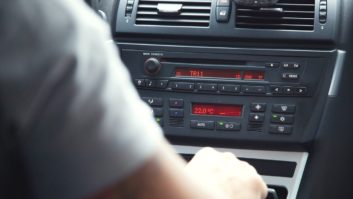
Galvin Manufacturing Corp. (later Motorola) developed one of the first
commercially successful car radios in 1930. It was the first product to
carry the Motorola brand. Designed to be mass-produced, affordable
and easily installed, its components as shown here, included, from left:
radio receiver, tuning control and speaker.
Credit: Motorola Solutions Archives
OTTAWA — The once-humble car radio is in the middle of a technological transformation. What started in 1930 as an AM/MW tube radio such as the Motorola 5T71 receiver is now a computerized multimedia entertainment center capable of playing Web-based streaming audio, MP3s, CDs and a mix of analog/digital radio broadcasts. The latest version of the car radio is not fixed in stone. As evolving customer preferences and emerging technologies combine to change the very nature of audio entertainment, car radio makers will keep changing this equipment in order to keep up.
CAR RADIO TRENDS
“There are two trends regarding radio in the automobile industry,” said Benjamin Oberkersch, Mercedes-Benz’s Connected Car & Infotainment spokesperson. “These are high-quality digital transmission formats, such as DAB/DAB+ and HD Radio; plus streaming audio, which is also known as Internet radio.”
To cope with these demands, automakers around the world have been adding the particular digital transmission formats that conform to their local standards; plus the ability for car radios to receive streaming audio via Internet-connected smartphones.
This second trend reflects a paradigm shift in car radio design. Rather than trying to develop some form of built-in mobile telephone capability to connect car radios directly to the wireless Web, car radio manufacturers are content to let their drivers’ smartphones handle this “last mile” link.
From an engineering standpoint, this strategy is akin to installing incomplete AM/FM receivers in cars. But since consumers have had to provide their own wireless Web connectivity since in-car audio streaming began, there is no sales resistance to this approach. This doesn’t mean that “embedded wireless modems” don’t exist in cars: GM’s OnStar in-car support service is proof that they do. But embedded modems are more the exception than the standard in cars these days.
“The constant evolution of smartphone equipment, plus the ongoing upgrades to mobile networks —– such as going from 3G to 4G —– makes it impossible for car radio manufacturers to select a wireless Web modem technology that will stay current,” explained Steve Brown, product promotions manager at Alpine Electronics of America, an aftermarket car radio manufacturer. “As a result, it makes very good sense for the car radio makers to let the smartphone makers carry this burden.”
DIGITAL RADIO’S PROGRESS
In Europe, car radio manufacturers are increasingly incorporating DAB/DAB+ into their car radios. A case in point: In the United Kingdom, “A quarter of a million new cars hit the roads in September [2014] fitted with a digital radio,” said Ed Vaizey, the U.K.’s minister for Culture and the Digital Economy.

Alpine’s X009-GM, the company’s new audio/video/navigation
system for GM trucks/SUVs with a nine-inch touchscreen. The screen
is showing an HD Radio station with metadata for artist name, song
name, album name and album art. Credit: Alpine Electronics of America
That’s up nearly 50 percent from September 2013. According to WorldDMB, the global body promoting digital radio, Audi, BMW, Ford, Jaguar LandRover, Mini, Volvo and Volkswagen are now installing digital radio as standard equipment in the majority of models. Ninety percent of new European vehicles are expected to come with digital radios by the end of 2015.
“Digital radio is the right technology for vehicles,” said Bertram Hock, BMW Group’s Section Manager Broadcast. “From the viewpoint of BMW the car industry is very well-equipped to exploit the multimedia potential across regions — preferably in the whole DAB coverage area.”
In other parts of the world, such as Asia and India in particular, potentially the largest digital market in the world, the interest of car manufacturers in the Digital Radio Mondiale (DRM) standard has been demonstrated, says Ruxandra Obreja, DRM chairman.
“The long planning cycle for car manufacturers and the availability of multistandard chipsets (from NXP, for example) means that OEMs and car manufacturers have already demonstrated in-car live DRM reception,” she said.
“It seems that major Indian car manufacturers are at the forefront of introducing digital receivers in the country since antenna, electricity consumption and costs are less of a problem than with a desktop or smartphone receiver,” said Obreja. And according to Yogendra Pal, DRM Consortium India Chapter honorary chairman, “more than six leading Indian manufacturers are expected to announce shortly the dates by which their cars will have built-in DRM radios.”

Mercedes-Benz’s COMAND system comes with hard-drive navigation,
car radio, CD/DVD changer and telephone controls, a music register with
4 GB of memory, a slot for SD memory cards, a Bluetooth interface
for mobile phones and the Linguatronic voice-operated control system.
Credit: Mercedes-Benz/Daimler
Logically, one would expect the new digital formats to push out the old ones; just as car CD players have replaced cassette tape players. But such is not the case with car radios, said Mercedes-Benz’s Oberkersch. “Of course, DAB+ is becoming more and more popular,” he said. “But FM is still the most used radio source in Europe.”
WHITHER AM/MW?
In the United States, HD Radio is making its way into the nation’s automobile dashboards. (Canada has no digital radio service, since its attempt to DAB in the 1452–1492 MHz band failed due to a lack of affordable radios and consumer interest.)
Technology problems recently motivated General Motors to drop HD Radio in its 2015 Buick Enclave, Buick Regal, Chevrolet Impala, Chevrolet Traverse, and GMC Silverado Truck. At the same time, “just as many new GM ‘platforms’ are adding HD Radio as are dropping,” said an August 2014 blog posting from Strategy Analytics, a technology market intelligence firm; “so the net is no change and the long-term outlook is for continued broad-based deployment.”
Compared to streaming audio, DAB/DAB+ and HD Radio, AM/MW is a technology from radio’s Stone Age, unless its digital version DRM is used. So when the news broke of BMW omitting AM/MW from its i3 electric car — mainly because AM/MW would suffer interference from the i3’s 125 kW electric motor — the carmaker’s decision to dump this antique technology seemed understandable.
This decision alarmed NAB President/CEO Gordon Smith. He wrote BMW of North America President/CEO Ludwig Willisch to point out that “BMW’s electric car competitors have addressed this AM signal interference sufficiently enough that their vehicles still come equipped with AM radio.”
According to Dominique Bonte, BMW’s decision does not necessarily reflect the demise of in-car AM/MW radio reception, but it does reflect all automakers’ willingness to drop old formats as consumer tastes change. “BMW also dropped the CD player from the i3,” noted Bonte, who is vice president and practice director at ABI Research, a technology market intelligence firm. “Other automakers are following suit as CDs decline in popularity.
The good news for broadcasters is that AM/MW receivers are inexpensive to include in car radios; CD players are not.”
ROAD AHEAD
Given all of these factors, the car radio of the future will likely continue to be an amalgam of old (AM/MW and FM) and new (DAB/DAB+, HD Radio, DRM and streaming audio) reception platforms.
“In Europe, cross-border mobile roaming plans make it very affordable to listen to streaming audio from country to country,” said Bonte. “Add the fact that wireless carriers may soon include car data delivery in their all-in-one consumer plans, and the market is clearly tilting in streaming audio’s favor.”
As for AM/MW? BMW notwithstanding, the days of this antique reception technology are not done yet, even if AM/MW seems quaint compared to digital radio and streaming audio.
James Careless reports on the industry for Radio World from Ottawa, Ontario.







